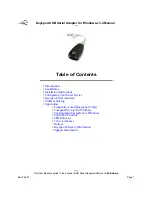
Page 8 of 62
™
2 vLoc3-5000 Receiver
2.5 Warnings and Alerts
Warning symbols are shown on the display and accompanied by an audible sound and vibration in the handle unless configured
otherwise in the MyLocator3 desktop app. Warnings can also be switched off in the setup menu.
94.6
Power 50
43dB
1.71m
Warning icons shown on the display
2.5.1 Warnings and Alerts Descriptions
ALERT
Alert Description
Signal Overload
- is usually caused by operating close to power transformers or being close to a transmitter
in Induction mode. Moving away from the interfering signal will solve the problem.
Shallow Cable
- alerts indicate that the locator has detected a possibly less than 15cm
(5.9-inch)
deep
cable. Proceed with caution.
Swing Alert
- indicates that the operator is swinging the locator excessively, resulting in misleading
information. When sweeping the locator across the direction of the line, try to keep it vertical; this will improve
its accuracy.
Overhead Cable
- alerts indicate that the source of the signal is mainly radiating from above. This alert is
usually caused by the signal traveling along overhead cables.
2.5.2 DFT (Discrete Fourier Transform)
DFT is a tool to assist in choosing a frequency to apply to the target conductor. The DFT feature will aid the user with nearby
interference that may affect the locate quality.
*Note the DFT feature should not solely be used to determine which frequency to apply. ALWAYS
follow the appropriate safety requirements mandated by safety legislation, safety practice, or your
company’s safety procedures when applying a locate frequency to a conductor.
1. To perform a DFT assessment, verify any nearby transmitters are powered off to avoid additional signal frequency
disturbance.
2. Select your preferred frequencies from the frequency menu. These selected frequencies will be assessed in the next few
steps.
Frequency
128Hz
480Hz
491Hz
512Hz
577Hz
815Hz
982Hz
1.02kHz
3. Navigate to the main menu and scroll until you see DFT. Select DFT by pressing the enter key.















































